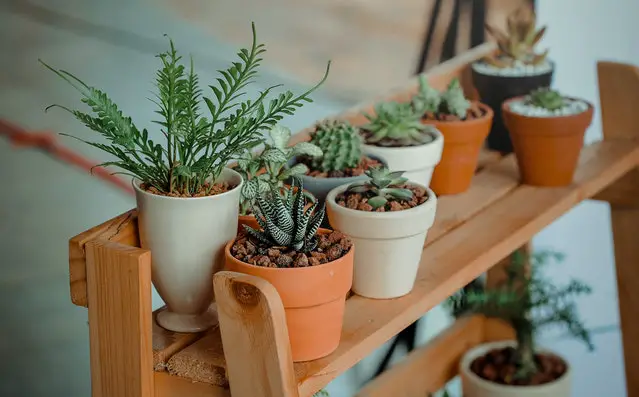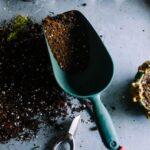The most crucial factor in ensuring that your home plants grow is a suitable living environment. The soil is one of the factors that determines whether or not your houseplant will thrive.
Some plants, such as a Peace Lily, thrive best when their roots are consistently submerged in damp soil. However, there are some plants that do not like this type of soil, and those plants often require their soil to remain dry for the majority of the time.
If you have a plant that prefers dry soil, you’ll need to provide it with the soil it prefers: well-draining soil. Most plant stores sell well-draining soil, but can you enhance the soil you currently have? Is it possible to make soil drain water more easily than it did previously? That is what we will cover in this article!
In this section, we are going to examine a variety of various items that you may incorporate into your soil in order to increase its drainage:
- Perlite
- Leca
- Pumice
- Wood chips
- Rocks
Let’s not waste any time and go right into the first section of our guide!
Read more: What you need to know about plant pot drainage holes
Table of Contents
Perlite
If you have previously purchased a well-draining soil mixture, you may have observed little white stones in the soil. The little perlite particles are represented by these white stones.
When purchased at gardening supply stores, perlite is a kind of vulcanic glass that has the appearance of a rock but is actually rather lightweight. This vulcanic glass contains large air pockets, which it may use to retain moisture, fertilizer, and oxygen for your plant. Additionally, it can also store oxygen. It does a terrific job of soaking up water and is an excellent technique to improve the drainage in your soil.
Because it does not compact like soil does, perlite prevents the soil from reaching an excessively compacted state. This not only makes it easier for water to drain away, but it also makes it possible for oxygen to reach the roots of your plant.
Perlite is an easy and inexpensive solution to increase the drainage of your soil, turning it into an ideal environment for plants that thrive in arid conditions. Additionally, it is incredibly simple to manipulate. The only thing required to make use of it is to combine it with the soil you already have and then apply it to your plants.
Read more: What Sort Of Fertilizer Is Best For Houseplants?
Leca
Leca is made up of baked clay pebbles. These clay pebbles are ideal for use in hydroponic gardening and come highly recommended. However, you may also employ them to enhance the drainage capabilities of the soil mixture you are working with. By incorporating Leca into your soil, you will be able to generate air spaces inside your soil. These air pockets allow more oxygen to reach the roots of your plants.
The Leca system is designed to precisely hydrate your plants by controlling the amount of moisture that reaches the plant’s roots. Because it can only hold roughly 30 percent of its own weight in moisture, Leca is an excellent choice for plants that thrive in arid environments.
The remaining seventy percent of moisture falls to the base of the container when it is drained. Because of this, your soil would hold on to a significant amount more of that moisture; however, Leca assists your soil to remain light and dry.
Simply watering your plant will cause the soil to become more compact over time. Due to the soil’s being more compacted, it becomes more difficult for water to drain and for oxygen to pass through. Leca contributes to the soil’s structure by helping to prevent it from being compacted.
Read more: How To Apply Neem Oil To Your Plants?
Pumice
Like perlite, pumice is something that comes from a volcano. Pumice is a type of vulcanic rock, in contrast to perlite, which is a type of vulcanic glass. In a hydroponics gardening arrangement, pumice makes an excellent growth medium for the plants. You may also combine it with soil in the same way that you did with Leca in order to optimize the movement of air and the form of your soil.
Both pumice and perlite have the potential to absorb excess moisture, which can aid your plant. Pumice is extremely comparable to perlite in this regard. It allows for excellent drainage as well as ventilation. Because it has many tiny air spaces, pumice is an excellent medium for recirculating fertilizer, making it an excellent choice for providing nutrition to your plant. When it comes to preserving the structure of the soil, pumice is superior to perlite. When it comes to preserving the structure of the soil, pumice is a lot more effective option than perlite.
However, there is a cost associated with gaining this improved capability to preserve the structure of your soil. The cost of using pumice as a medium for your plants is higher than the cost of using either perlite or Leca.
Fragments of wood
The use of wood chips is an effective method for aerating and aerating the soil for your plants. These wood chips come in substantial chunks that don’t vary much in size from one another. It is easier to keep the form of your soil when larger pieces are present. This is because larger chunks do not truly alter size when they are exposed to water, as is the case when you water your plant. These chunks aid in the rapid evaporation of water and allow the soil to retain just a trace quantity of moisture, which is beneficial for plant growth.
When your soil cannot compress due to bigger stones in it, it dries up faster. It dries off more rapidly due to the rapid drainage of any extra water that may have accumulated. Your plant may use the moisture that is drawn up from the wood chips themselves, which also absorb a little quantity of moisture.
The drainage of your soil may be significantly improved with the very low cost use of wood chips. However, because it is formed of organic material, it cannot be left in wet soil for an extended period of time. The wood chips, much like the soil and the roots, are susceptible to rotting. You may prevent this from happening by using wood chips and perlite in order to enhance drainage and prevent rotting.
Read more: Can You Take A Houseplant Outdoors?
Rocks
Rocks provide an excellent option for you to consider if you are looking for a method to ensure that your plant is always kept in a dry environment. Rocks do not take in any moisture and their sole purpose is to maintain the structure of the soil in which they are found.
Rocks, which do not absorb any of the moisture that they come into contact with, are an excellent choice for areas that need to be dried off. The various methods that we have outlined each absorb some amount of water, which helps to maintain part of the moisture that is already present in the soil.
Because rocks are impermeable to water, the only component that may retain moisture is the soil. The rocks have no other use except to ensure that the soil is stable and to facilitate the rapid drainage of precipitation to the ground below. Because of this, it is an excellent medium for plants that must spend the majority of their time in a dry environment, such as cacti and succulents.
Conclusion
We discussed numerous methods for assisting your soil to drain water more rapidly in this post. There are a variety of plant species, each of which has its own preferences for the ideal soil moisture level. These plants require our assistance in establishing themselves in soil that dries up more rapidly.
To achieve this goal, we can amend the soil using either perlite, leca, pumice, wood chips, or rocks. This aids in the soil’s ability to drain water more quickly and expedites the drying out process. Your plants will be extremely pleased with the additional drainage that you can provide for them if they like soil that is dry.
I appreciate you taking the time to read my article. I really hope that this information is of use to you in maintaining the health and beauty of your plants.
Read more: What Exactly Is Leca, And Why Is It Beneficial To Plants?
Frequently Asked Questions
Can you mix Leca with soil?
The drainage of your soil may be significantly improved by combining Leca with the soil. When you add Leca to your soil, you are introducing particles that are able to hold far less water than the soil itself, which in turn makes it easier for oxygen to reach the roots of your plant.
What is the difference between Perlite and Pumice?
Both pumice and perlite belong to the vulcanic rock family. The primary distinction between pumice and perlite is that pumice is significantly more rigid than perlite and has a greater capacity to keep the structure of your soil intact. This indicates that it has the potential to prevent the soil from becoming more compact over time.
Read more: Houseplants Growing MediumRead more: What Exactly Is Vermiculite, And How May It Be Used With Houseplants?
Photo by Min An: https://www.pexels.com/photo/green-indoor-potted-plant-lot-793012/



